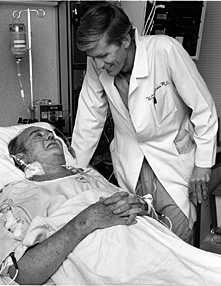| As early as the 1950's, there had been an effort of to produce a reliable artificial heart for humans. During the 1970's, animal trials of artificial hearts were mostly succesful, leading to optimsm that such devices could be made available for human use in the near future. The result was the Jarvik-7, a pneumatic-powered pump made of alumium and polyurethane, whic would be attached to the patient's own atria (auricles) once the rest of the heart was removed. It was powered by pulses of air through tubing from an external power console that was roughly the size of a household refrigerator. Researchers at the University of Utah, including Dr. William Kolff, head of the artificial heart program, Dr. William DeVries, head cardiac surgeon at UU, and Dr. Robert Jarvik, developer of the Jarvik-7 artificial heart, soon decided that the time had come to test the device in a human patient. However, it would take two years of searching to find the right candidate. Dr. Barney Clark was a perfect candidate for the Jarvik-7, he suffered from severe heart desease in the absence of any other serious system failure He was also over 50 years old, and thus inelligible for a typical heart transplant. Dr. Clark was hesitant when first approached about the procedure, due to his recently improving health. However, his health began to worsen in November of 1982, prompting him to agree to the transplant. Clark underwent a 7 and a half hour proceedure to implant the artificial heart, and the surgery was hailed as a success. When word of the operation reached the public, it created a worldwide media sensation. Although Clark was confined to his hospital bed by the immense support unit connected to the heart, he survived for 112 days with the Jarvik-7 doing the work of his heart. On March 13, 1983, Barney Clark died, but he had given his life in the hope that his transplant would further artificial heart technology and thus save lives. Since 1982, over 350 people have used the Jarvik-7 artificial heart, and it is still in use today, mostly as a bridge to traditional transplant. Newer, improved versions of the artificial heart have also emerged, such as the Jarvik 2000. Dr. Clark's courage continues to save lives even to this day. |
| The 80's History Project Science 1st Artificial Heart Transplant December 2, 1982 |
 |
| The Jarvik-7 artificial heart |
 |
| Barney Clark, with Dr. William Kolff |